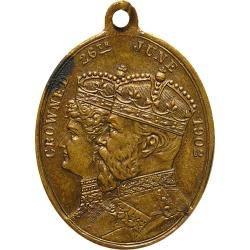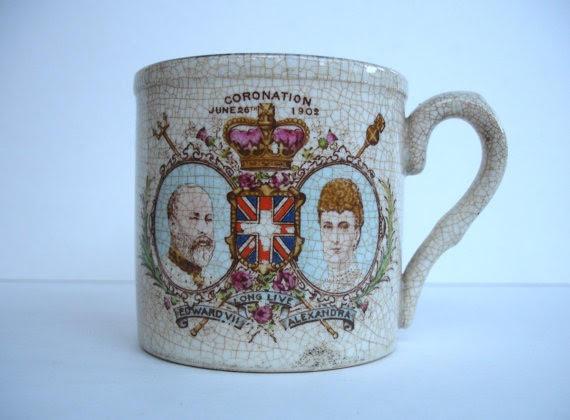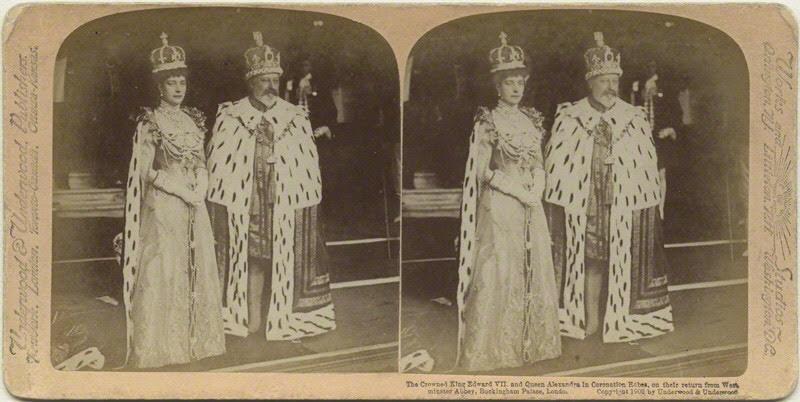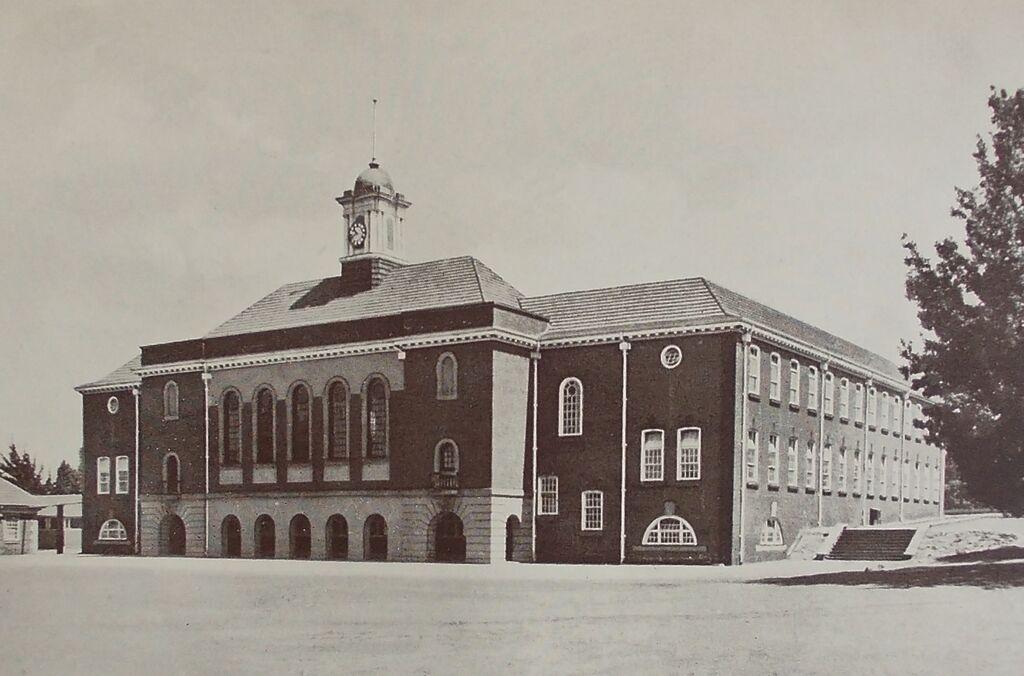Disclaimer: Any views expressed by individuals and organisations are their own and do not in any way represent the views of The Heritage Portal. If you find any mistakes or historical inaccuracies, please contact the editor.
In searching the archives or trawling through book finds, one sometimes encounters two items in different places that have a relationship and a natural belonging. This happened recently when I discovered a cache of Johannesburg photographs decked out to celebrate the coronation of Edward VII in June 1902. Some months later in a batch of recently purchased pamphlets I found the official Programme for the same 1902 coronation celebrations in Johannesburg. Putting together two quirky and chance survivals opens up a window on the world of Johannesburg in 1902.
The first find was a set of photographs of Johannesburg located in the Wits architectural archive. These are eight clear sepia tone photographs of Johannesburg decked out in bunting, flags and celebratory wreaths and adornment set to celebrate the coronation of Edward VII set for June 1902. The photos carry a stamp on the rear showing they were from EE Saunders, photographer of 88 Marshall Street.
The centre of festivities was Market Square and believe it or not this extraordinary pastiche of a series of three Indian triumphal arches topped by two domes and a turret was erected. The slogans were "Indians greet their Emperor", "Loyalty to Kin and Emperor". This fanciful structure and more more beyond (see the background) stood where the Town Hall was later built.
The centre of festivities was Market Square
My second find was the Official Programme of Johannesburg celebrations dated June 1902 priced at 1 shilling and published by Gilchrist and Powell of Johannesburg. It shows a small vignette of Edward VII on the cover.
Cover of the Official Programme
Both these items are good examples of ephemera of the collectable variety and appeal to those who collect or document Johannesburg material or are keen on Royal history. They are also an example of a find that triggers research and raise some questions about context and what such items tell us about the society.
Firstly, this was the year that the Anglo Boer War ended and the Peace of Vereeniging was signed in Pretoria just a few weeks prior to the planned crowning of Edward VII. The date was 31st May 1902, following the gathering of burghers and commando leaders in Vereeniging the key figures signed the treaty at Melrose House conceding defeat on the part of the two Boer Republics. You can still see the table where the signing took place in the dining room of Melrose House, opposite Burgers Park. The Transvaal became a Crown Colony administered by Milner who made Sunnyside, Johannesburg, his base and gathered round him a group of bright young men as pacifiers and administrators who became his key civil servants and were known as the Milner kindergarten.
Signing of the Peace of Vereeniging at Melrose House
Johannesburg had been occupied by the British in 1900, so its support for all things British and Royal may have dated back to that date. Queen Victoria was still alive and in May 1900 the relief of Mafeking was celebrated on London streets with such gay abandon that the term "maffick" passed into the English language as an expression for a excessive jubilation. Queen Victoria died in January 1901 and so ended the Victorian era and with the ascent of her eldest son Edward VII to the throne the Edwardian decade dawned. Born in 1841 he had been the longest serving Prince of Wales in British history, at that time. He ascended the throne at the age of nearly 60.
The programme for the Johannesburg Coronation Celebrations informs us of the type of celebrations planned: a military parade of Rand Rifles, plus inspection of troops, a religious ceremony, sports at the Wanderers' Club (including cycle races), a reception hosted by the High Commissioner, Lord Milner, at Sunnyside in Parktown, illuminations, a state concert, free cinematograph entertainments at Markham's corner were all planned for 26th June. On the next day, Friday, 27th June there was to be a procession, a children's picnic, a gymnastics display, a night procession and fireworks. On Saturday, 28th June there were to be races at the racecourse and a repeat of the State Concert. The planned Gymnastics display included a "war dance in full war paint, by 200 full-blooded Zulus". It was to be a three day affair.
Sunnyside (The Heritage Portal)
I find particularly intriguing and revealing that each page of the Programme carries a series of promotional slogans for liquor, beer, wine, whisky, sherries, ports, claret, burgundies, champagne. Johannesburg citizens were encouraged to quench their thirst. The many advert pages included in the official programme give a wonderful glimpse of business activity in the city and the type of wares available.
One reads into a celebratory Programme and photographs, an empire moment of triumphal assertion of British power and authority, pacification, control and reorganization and reconciliation. Peace had returned after a bitter war and a royal coronation became a grand occasion to bring pomp and circumstance to the Highveld. Parties and parades were devices to declare loyalty and visible signs of the new order. Royalty and a display of flags were symbols of the vast confident British empire, stretching from Canada to India, from South Africa to Australia. Not everyone in the Transvaal welcomed the new order but there was a sense of inevitability, with Smuts and Botha arguing for reconciliation. Many Johannesburg uitlanders had always been opposed to the ZAR government so celebrating a royal moment would have been a great deal more popular than in say, Pretoria. The Coronation was meant to be a popular and populist event engendering a warm feeling around the empire, serving much the same purpose as the Golden and Diamond Jubilee celebrations of Queen Victoria in 1887 and 1897.
The changing of the guard and the coming to the throne of Edward VII was celebrated too in stamps, medals, and memorabilia such as commemorative mugs and cigarette cards. Collectable and popular these items went into display cabinets and philatelic albums to be passed to future generations. Note the coronation date on the medal and mug... 26 th June 1902.
A Coronation Medal
Commemorative King Edward VII / Queen Alexandra Mug
A pair of stereoscope pictures of the King and Queen
A contemporary account of Johannesburg in festive mood was that of T R Adlam, which was published in the 1986 Van Riebeck Society commemorative, "Johannesburg Pioneer Journals 1888-1909" edited by Maryna Fraser. Adlam's father, Richard was a horticulturalist and the first curator of Joubert Park. Tom Adlam was born in 1888 and died in 1983 in Edinburgh. Adlam wrote his memoirs in the late 1950s so the capture a nostalgic and distant childhood and youth in Johannesburg. Adlam, remembering the 14 year old he would have been in 1902 wrote,
Elaborate preparations were made in honour of the Coronation of King Edward the Seventh... With peace restored the citizens of Johannesburg were in a festive mood and prepared to let themselves go. The town was decorated as never before in its history. Everybody, from far and near, went to see the great triumphal arch outlined with thousands of electric lights, erected in Market Square; a firework display of unprecedented magnificence was arranged in the Wanderers' Grounds, schoolchildren were to have a special bean feast at the town's expense with vast quantities of ginger beer - many barrels of it we noted with glee. In our garden , alongside the house, a tall sapling was erected for a flag pole, and a splendid large red ensign flew from it.
However there is a catch in this tale of jubilation and jollification. The coronation of Edward VII and his queen, Queen Alexandra was set for June 26 1902 in Westminister Abbey. Parades were planned, hotels giving prime view positions of the processions were booked, fine clothes ordered by the guests, imperial troops arrived in London. Then the whole glorious event was cancelled at short notice. Why? Edward VII fell ill and needed an operation for an abdominal abscess.
Adlam's memoir continues :
Then suddenly came the news of the critical illness of the King, the postponement of the Coronation and the cancellation of all festivities. From our point of view, this was a tragedy. How the ginger beer was disposed of, we never really understood; certainly, we never officially received our share of it. But Duncan and Eddie Lee discovered that the barrels stacked at the Wanderers' Grounds were not all empty, so thither we went with our tin mugs, climbed the fence, and drank to our fill, to the health of His Majesty, in some of the most excellent ginger beer I have ever tasted... About two months later when the King had recovered and his Coronation celebrated, the jovial mood seems to have past; the gilt, so to speak, was off the gingerbread, and beyond the fact that we got another holiday, I can recollect nothing special of the event."
The Coronation souvenirs still carried the date, 26th June, they could hardly be withdrawn but this was the Coronation celebration that fell flat. However I did find a photograph of the impressive Coronation Parade of Imperial Troops on Johannesburg's Market Square which dates 9th August 1902. That indeed was the date of the Coronation in London.
Coronation Parade of Imperial Troops on Johannesburg's Market Square
Despite the inauspicious start to the reign of Edward VII, he proved, despite his earlier playboy reputation, to be a capable , serious and concerned monarch who brought the British Empire into the 20th century and enhanced the role of Monarchy.
King Edward VII School (KES)
In Johannesburg in 1902, the Johannesburg High School for Boys was established by the Milner administration. This school later relocated to Barnato Park and in 1911 new school buildings were erected in Upper Houghton on the edge of Yeoville. Following the death of Edward VII in 1910 and to commemorate his memory, it was decided to name the school King Edward VII school. It was a boys school designed to promote and cultivate manly Anglo saxon values, a military mien, offered an advanced education and moulded the characters of many young man who readily volunteered to fight for King and Country in both the First and Second World Wars. It is a school that still celebrates Remembrance Sunday; it has a fine war memorial in an old quadrangle, houses one of the most extraordinary school museums I have encountered. The dual portraits of King Edward VII and Queen Alexandra still hang in the Preparatory School Hall and today little eight year old boys face those portraits as they sing in sweet treble voices, the South African National Anthem and parents and grandparents recall the legacy of 1902 and the Empire King.
Old image of KES (SA Builder Magazine)
The Cullinan Diamond
There was yet another fascinating sequel. In 1905 a gem quality diamond weighing over 3000 carats was discovered at the Premier No 2 mine at Cullinan near Pretoria. The Diamond was purchased by the Transvaal Colony for £150000. This gem was named the great Cullinan Diamond. In 1907 the new Prime Minister of the Transvaal Colony, General Louis Botha, (the Transvaal had only recently been given the status of responsible government) proposed that the Cullinan Diamond be presented to King Edward VII, as "a token of the loyalty and attachment of the people of Transvaal to his throne and person". It was a controversial move. Nonetheless, the gift of this giant unique diamond was presented to the King on his birthday. The Cullinan Diamond was ultimately cleaved and cut in Amsterdam into 9 major stones and 96 smaller stones.
Edward VII had the Cullinan I and Cullinan II set respectively into the Sceptre with the Cross and the Imperial State Crown. How extraordinary that Edward VII accepted the gift from his newest Colony. Was this an authentic and generous gift of loyal subjects of the result of political machinations, ambition and raised expectations of favours given and anticipated? A further interesting side note was the repurchase from the Dutch diamond merchants tasked with the cutting job, by the new Union Government of 1910 of the many smaller "off cut" stones and their presentation to Queen Mary (wife of King George V) on the occasion of his coronation in 1911 by the Union Government. I recall reading that Queen Elizabeth II referred to these diamonds as "Granny's chips".
A Final Note
And what about those Zulu warriors? Yet another foot note to history was added when in 1906 the Bambata Rebellion took place in Zululand over the question of the newly introduced poll tax imposed on African households. The uprising was brutally suppressed by Natal colony troops with the deaths of some 3000 to 4000 of those Zulu warriors. In 2006 the clan chief who led the uprising Bambata was proclaimed a national hero. Edward VII was King of the Natal Colony.
Comments will load below. If for any reason none appear click here for some troubleshooting tips. If you would like to post a comment and need instructions click here.




